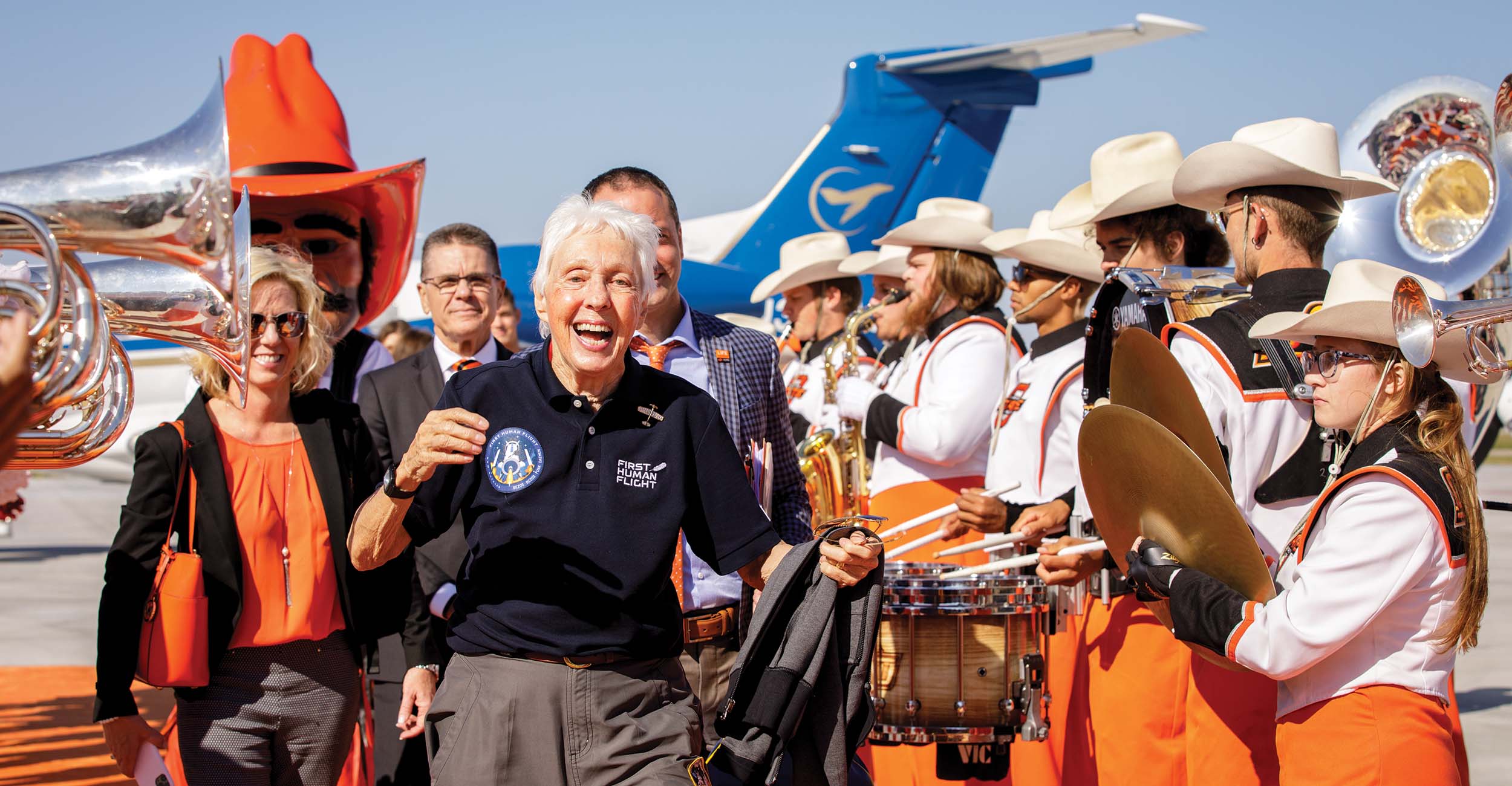
Cowboys in Space: OSU alumni breaking barriers in space
Tuesday, December 14, 2021
Media Contact: Mack Burke | Editorial Coordinator | 405-744-5540 | editor@okstate.edu
Alumna’s joy embodies her passion for life with no limits
Oldest woman in space, Wally Funk, 82, returned to visit her alma mater in October. Arriving at Stillwater Regional Airport, she was greeted with an orange-carpet treatment, fanfare, media and celebration. She struck the same pose stepping from the plane as she did emerging from the space capsule, arms thrown wide, and the same one she shares at presentations, lunches and photos — grand, dramatic and the epitome of Wally.
She was exuberant. With the OSU Marching Band playing, she danced down the orange carpet with Pistol Pete, hugged students and took questions from reporters. She dramatically demonstrated the safety belts necessary for the trip into space with Jeff Bezos’ Blue Origin.
“The launch was so fantastic. You can’t believe it. We learned to sit in and out of our seats a lot. My seat was No. 3. And you have to strap, left, front, this one, this one and be completely buckled in hard,” Funk said. “And they would come check and see if it was hard enough, and if it wasn’t hard enough, he would just do it for you. I sat there, and we took off, and it was fantastic.”
'This is the Best'
A special event was held in Funk’s honor at The McKnight Center for the Performing Arts that evening.
Dr. Jon Pedersen, dean of the College of Education and Human Sciences, presented her with a plaque commemorating the Wally Funk annual scholarship for aviators in the professional pilot program.
“I’ve led a very charmed life,” Pedersen told her. “I’ve met a lot of people, presidents, dignitaries. And I’m sincere about this, Wally: This is the best.”
Dr. Kat Gardner-Vandy, assistant professor of aviation and space, credited a book about the Mercury 13 for inspiring her to get her pilot’s license. She was the only female in the class.
“I knew I had a place there because of this book,” she said. “Enthusiasm can get you so far, but it’s really perseverance, tenacity and grit that will really propel you forward. And I thank you for being that role model for me and where I am today, but also for all other young women.”
Answers and Wisdom
A Q&A session was scheduled next. A tidy list of questions had been prepared, two seats made ready on an inviting, bright stage.
But Funk would not be tamed. The questions went out the window as she marched on stage, arms wide and expressive, talking to the audience more than any would-be interviewers. She insisted the house lights be raised, and with her whoops of appreciation, they were. She celebrated the young members of her old sorority, Alpha Chi Omega. She cheered with the Flying Aggies, snapped photos with the camera she brought onstage, bathed in the spotlight and adored the adoring.
“It was so fantastic seeing everybody in that audience,” she said. “I wanted to go and hug every one of them.”
Then she shared wisdom that only Wally Funk can share:
- “Stress is when you lose faith and then you get fear. Do not lose faith.”
- “Negativity contaminates your energy.”
- “If your goal is to keep saying ‘yes I can do it,’ keep moving forward with confidence.”
- “Don’t ever sit on a pile of negative.”
- “Any woman who does not enjoy camping across the country on a clear, frosty morning with a good horse and a gun and a pair of dogs doesn’t know how to enjoy life.”

A Global Life
It would be easy to publish a chronological list of her accomplishments, an asterisk marking the moments she broke the glass ceiling for women.
There were the 2½ years in her 20s that she spent traveling 80,000 miles through 59 countries in Europe, Africa and the Middle East, covering most of the distance in a VW camper with a dog named Little Toot.
The years when she was the first woman to work as a plane crash investigator with the National Transportation Safety Board could be noted, or her time that made her most renowned as one of the Mercury 13, a 1960s program that put a group of young women through testing to become astronauts before the program was canceled without explanation.
A list of pilot certifications she holds would be appropriate to note, the vast majority she earned at Oklahoma State University. Over six decades, she’s introduced about 4,000 people to flying and shepherded 3,000 to private pilot’s licenses.
But a catalogue of her accomplishments has been done before and is too long to list here.
So why was Wally Funk so successful? Why did she brush off society’s gender stereotypes and march on with unquestioning faith in her next move?
She grew up at 7,000 feet in Taos, New Mexico. A combination of aristocratic ideals of proper presentation and manners mixed with freedom granted by her parents enabled her to pursue what she wanted, when she wanted. As long as her manners were in place and she looked presentable enough, Funk could set her own agenda.
In small 1940s Taos, Funk came and went, riding horses, target shooting, skiing, taking part in adventures and spending days with the Taos Pueblo Indians. So great was her freedom that her mother, Virginia, would ask her, “Where will you be sleeping tonight, Wally?”
Funk would reply, “‘I don’t know. Maybe in the barn, maybe my tree house, maybe on the floor, maybe out at a pueblo.’ They never, never asked me twice,” she told the crowd at McKnight. “I owe a bunch of my success to my parents.”
'Throw It A Fish'
Funk also steers clear of the negative that comes her way. Others may store it in their hearts like a packed trunk, considering and reviewing, stewing over an ugly sentiment, wasting precious energy and time. Funk said the Taos Pueblo Indians taught her to “throw it a fish” when someone said something hurtful.
She was denied a job at an airline, reportedly because it lacked a women’s restroom in its training facilities. When she wanted to take male-dominated classes like auto mechanics or engineering, she was told to enroll in home economics.
Each time she was disappointed, she “threw it a fish” and moved on.
“It means, ‘Let it go,’” she said. “The Indians taught me if someone is not nice, throw it a fish and walk away."
On to OSU
Before her senior year in Taos, Funk boarded a train for Stephens College, a girls’ school in Missouri. It was a place of rules and feminine expectations, dresses and dress shoes. Funk was happiest in jeans and T-shirts. She found a compromise by studying physical education, where she could be more casual in the gym. But a skiing accident that cracked her vertebrae ended that.
When the dean called her mother, warning that Wally was not doing well in her classes, Virginia asked the dean if there was an airport in town. He said there was. Her mother said, “Well, get her out there, and set her flying.”
She became a member of the Flying Susies at Stephens College. They competed at flight competitions, but another group always won.
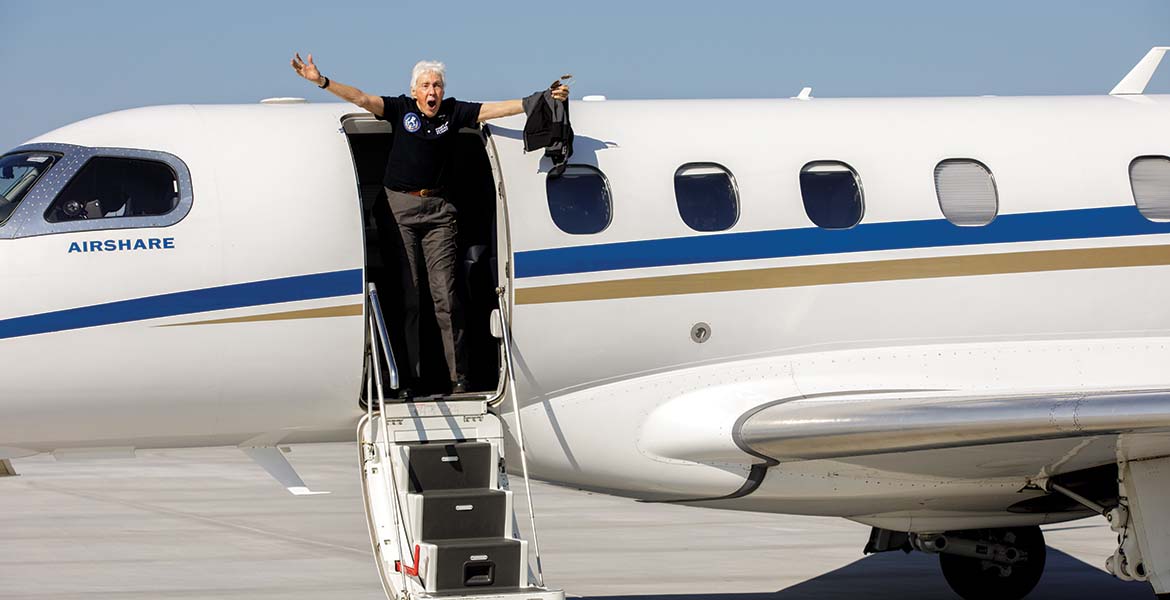
She told the crowd at The McKnight Center, “How do you think I got here? I was a Flying Susie at Stephens. Who do you think I competed against? I competed against you guys, the Flying Aggies. You all won time and time and time after time. … And so, my parents said, ‘Are you going to come to Illinois or Indiana for school?’ I said, ‘No, I’m going to Oklahoma State, and you can drive me there tomorrow.’”
She earned every certificate OSU had to offer, including single engine seaplane, which she earned by flying a Piper Cub that was outfitted with pontoons at Lake Carl Blackwell or Boomer Lake in town.
She had clear words of instruction for anyone wanting to be an astronaut, singing the praises of STEM (science, technology, engineering and math) education. She said the media got it wrong: She was not rejected as an astronaut because she was a woman, but NASA said it was because she didn’t have an engineering degree.
The Space Dream
In 1961, Funk was testing with Mercury 13. Her dream to this day is to be an astronaut — and she’s still striving for a visit to the International Space Station. The NASA researchers probed and prodded, made her swallow three feet of hose, drink a pint of radioactive water, put freezing cold water in her ears — which amounted to three to four seconds of excruciating pain — and put needles in her hand to test her nerves. Instead of focusing on the pain, she counted herself lucky that she was included. They placed her in a sensory deprivation tank and left her in the darkness to float in water the same temperature as her skin, rendering it physically invisible. She floated for more than 10 hours.
There were some who couldn’t tolerate the absence of sensory perception or the claustrophobia of being locked in a tank. She thought at one point as she lay in the blackness, “What an exciting adventure I’m in.”
When Bezos contacted her, Funk, who has not kept up with modern conveniences like online shopping, didn’t know who he was. But she was delighted with the opportunity. She launched with Bezos, his brother, and an 18-year-old student skyward on the rocket New Shepard, to spend a few minutes 62 miles above the Earth’s surface.
“When we got into space, it was so fabulous,” she told The McKnight Center crowd. “The whole flight was so easy, it was incredible.”
The vehicle landed so gently she couldn’t feel it. Of course, she wants to go up again — to the ISS.
At 82, Funk continues to turn out new pilots. She fell in love with planes at 7 years old and has never fallen out of it.
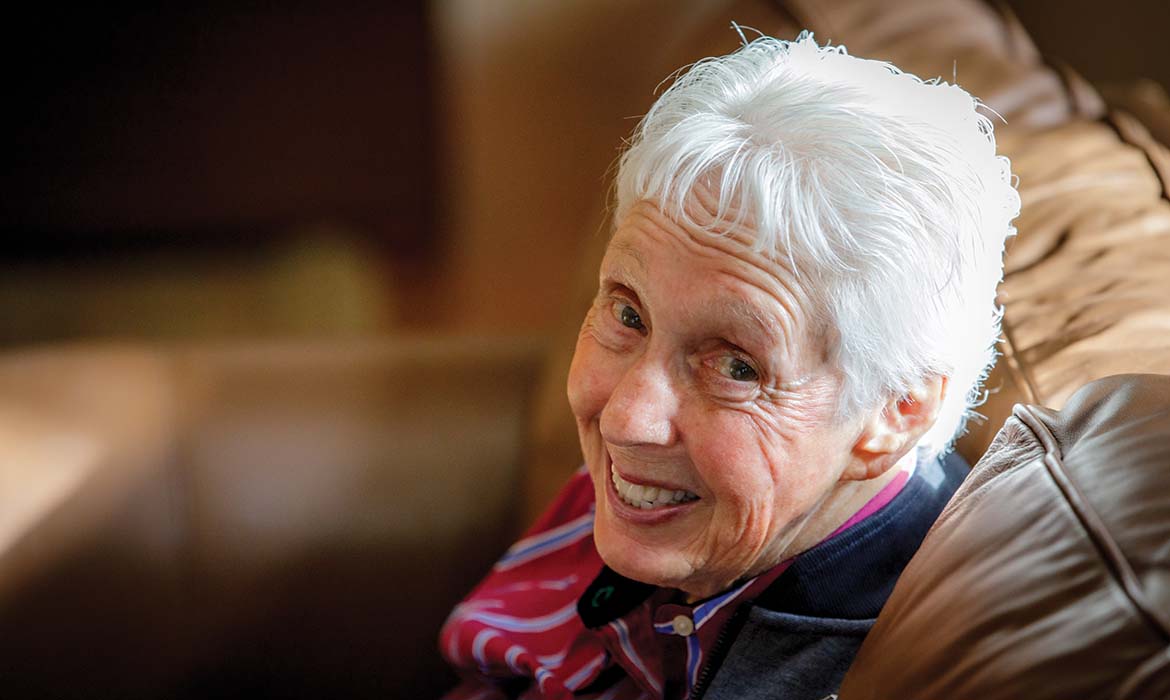
For so many people, life contracts and narrows as they top 70 and 80. They pack away their dreams as if they’re no longer allowed or proper, and they retire as good folk are supposed to do. COVID-19 is the closest Wally Funk has come to retirement. The pandemic brought her the most difficult time of her life with unaccustomed boredom and isolation.
The series of events at Oklahoma State brought her new levels of unmitigated joy. She has no plans to stop teaching, speaking or inspiring.
“Honey, I’m going to go to 120,” she said. “You have to be your own person. Don’t let anyone tell you what you can and cannot do.”
Cowboys in Space: OSU graduate helping Virgin Galactic open space to tourists
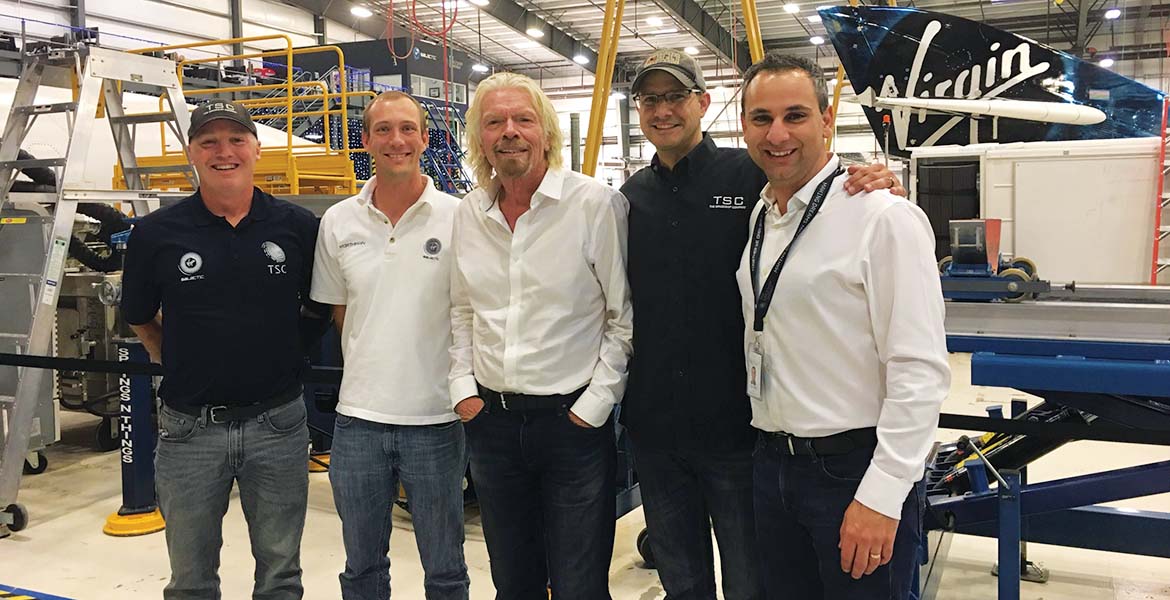
When Oklahoma State University alumnus Jonathan Ritchie interviewed with The Spaceship Company, he arrived in the windswept desert of Mojave, California, to find empty buildings and empty spaces.
His tour was comprised mostly of imagination; a guide pointed out where a composite manufacturing line would go, the spot across the way where the assembly warehouse would be constructed.
About two dozen employees were working under the leadership of British business magnate Sir Richard Branson and aerospace engineer Burt Rutan at the time. They had all signed on to work on one wild proposal: make commercial space tourism a reality.
“It was literally a small group of people in the desert with an idea,” Ritchie said. “I just ate that up. I said, ‘I am in. Let’s do this.’”
Just Work Harder
Ritchie had a strong work ethic. That, along with a “‘What could I do if I tried?’ attitude,” has taken him to a managerial position with Virgin Galactic, a company dedicated to opening suborbital space flights to the world.
Ritchie, who grew up fascinated by the long-outdated technology of steam engines, knew he would be an
engineer.
His father was a teacher. His mother, a geophysicist, invented a 3D radar used to find pockets of petroleum. His older brother earned a perfect score on a college entrance exam.
“I knew real quick I was never going to be the smartest guy in the room,” he said. “I thought, ‘OK, I’ll just have to work harder.’”
He chose Oklahoma State for an undergraduate degree. It was close to home, he had older siblings in attendance and after some research, he believed it would serve him best for an engineering degree. He couldn’t pursue his passion for steam engines, so a week before school started, he paged through the course catalog to decide the type of engineering for his major. He found mechanical engineering with an aerospace option.
“I thought, ‘Well, mechanical engineering, that sounds like me, and with an aerospace option, now that has pizzazz. That has flair.” he said.” Who is not excited about space? Right? It has space in the name.’”
As he was transitioning from general courses to degree specifics, Ritchie said he got lucky when aerospace was separated into a separate degree program. He decided two bachelor’s degrees would give him a leg up in the workforce, and it fit his life philosophy to “just work harder."
Taking Chances
Ritchie met his wife, Sara, at OSU. The start of their relationship is clearly marked by a particularly “dark period” on his transcript when studies suddenly became less important. As the sun was setting one evening on a rural hill outside Stillwater, he dropped to one knee. He was in his third year at OSU. He didn’t have a ring, but the moment was too perfect to let pass. He asked her to marry him but interrupted her before she could reply.
“I said, ‘Now before you answer, you need to know — someday, life is going to be good. We’re going to have a family, and I’m going to have a job. And I’m going to come home one day and tell you, Honey, I’ve done a thing. I quit my job, and we are going to do this crazy thing.’”
She said “yes” anyway. They married and had their first child before he graduated.
His was the first graduating class after 9/11. He had come to terms with the idea that he probably would have to leave Oklahoma to get a job in aerospace, but he could find no aerospace jobs at all.
He picked up a copy of “Jane’s All the World’s Aircraft” from the library. He applied to every aerospace manufacturer in the U.S. and Canada. He snagged one interview in Texas, but the job didn’t pan out. After a year of searching, he was hired by a privately owned Oklahoma City aerospace company.
“We were a repair station, so every morning you show up at the loading dock to see what arrived,” Ritchie said. “Some guy somewhere has a jet that can’t fly because there’s a broken part somewhere in this box, and you better fix it and get it back to him. It was drinking from the firehose. You had to learn fast. It was a phenomenal experience.”
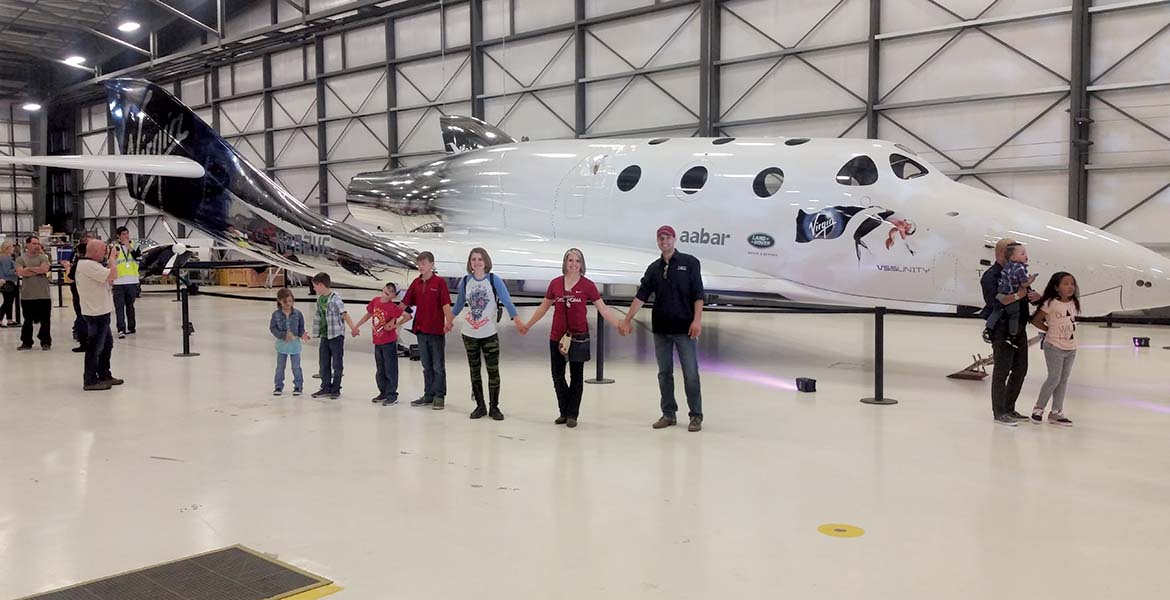
After a year, Ritchie moved on to a job at Nordam, an aircraft product and service company in Tulsa, grateful he could have a career in aerospace in Oklahoma. And then his boss left for The Spaceship Company. Ritchie was happy at Nordam, but one question nagged him.
“Could I join him if I tried?” he thought. “Could I succeed there if I really tried and worked hard at it?"
Four months later, he applied for a job with The Spaceship Company as a program manager
for interior development, responsible for all aspects of the project being done right,
on time and on budget. He had never been a program manager
before.
At home, four more children, including one set of twins, had followed the first.
“I always thought I was going to start my own businessdoing something,” he said. “Instead, it was ‘Hey, honey, I quit my job, and we’re buying an RV and moving to California because I’m going to work on spaceships.’”
They put their house on the market. They packed up their family of seven — five children under the age of 11 — along with the bare necessities and a chocolate lab named Murphy. They hit the road in a 24-foot camper on a blustery January day as subzero temperatures and snow blanketed Oklahoma behind them. Ritchie likens it to a “Grapes of Wrath” migration. They softened the blow of change by calling it their “five-year California vacation plan.”
“We would make dinner and then it’s like, ‘OK, kids, everyone stand up. It’s time for bed’ so we could turn all the seats into beds so we could lay down. It was one of those things that I look back and think, ‘Good Lord, why is Sara still with me? She has been in with both feet wherever I go,’” he said.
Opting for Flair
When Ritchie arrived in Mojave, The Spaceship Company was jointly owned by Scaled Composites and Virgin Group. In 2012, Virgin Galactic would become the sole owner. But in 2011, Scaled Composites had prototype vehicles that needed an interior suitable for paying passengers. The interior behind the pilots’ seats could be merely functional and efficient or it could have Virgin flair. Ritchie and the company opted for flair.
“Do we make this very utilitarian so that it looks like a NASA experience that people
have seen, or do we say, ‘No. This is a Virgin Galactic experience, and we are going
to give you the full-up, complete, everything you want to experience.’”
A trip on a Virgin Galactic ship takes passengers higher than they’ve ever flown before — even before being released from the mothership, up where the atmosphere fades to black, and the divisions and boundaries that mark existence on earth disappear. Round windows line the sides and top of the craft, offering maximum visibility whether passengers are strapped in a seat or floating around the cabin. The seats are mounted to the sides of the fuselage, providing valuable maneuvering space underneath.
Ritchie later accepted the job as the program manager for spaceship serial No. 1, Enterprise, which was being built by Scaled Composites. Ritchie had to receive it, get all the knowledge transferred and obtain all the ground support equipment. He took a team of engineers and embedded within the Scaled Composites facility.
“Those were some fun days,” he said. “When I wanted to have a meeting, we would literally go out and sit on the hangar floor, under the spaceship in a circle and talk through what we wanted to do. We would look at each other, like we are really doing this. It was awesome.”
By 2016, Ritchie was the program manager for Unity, spaceship serial No. 2, and he had absorbed the duties of the chief engineer as well.
“Following that same mantra — ‘I’ll just succeed by working harder’ — I looked up one day and realized my kids are growing up, and I’m missing it,” he said. “And this program is cool, but it’s not worth them.”
Ritchie resigned.
Rather than accepting it, wishing him well and posting his job, Virgin Galactic leaders asked why. He told them he was doing the job of the program manager and the chief engineer role, and it was taking too much. His family needed more of his time and attention.
“They said, ‘Which job would you stay for?’ I said, ‘Chief engineer.’ So at that point, I became chief engineer of Unity, and someone else got to be program manager, so I didn’t have to chase parts or worry about fabrication status. I could focus on what really energized me, which was engineering.”
‘Mothership’ and Platforms
Before Covid, Ritchie did stand-up meetings with his lead engineers on a platform high in the hangar.
“At the end, I have everyone put their hands in the middle and yell, ‘One, two, three, spaceships!’ It’s been a fun place to work for sure.”
As Virgin Galactic has taken people to space, the company has transitioned from a development mindset to production. Necessary changes were made for the new direction, and Ritchie moved from chief engineer to director of systems engineering.
The company has continued to grow, with more than 1,000 employees today. Some of them are what he calls “airplane people,” and others he loving refers to as “space cases,” because they are consumed with space. Ritchie, though, has an engine out of a Stanley steam car in his garage.
“It’s one of my prized possessions,” he said. “What does it do? Absolutely nothing but sit there.”
His family’s five-year California vacation plan is now on year 11, and he wouldn’t change a thing. He gets to use the word “mothership” in his everyday conversations. Did he lay out the plans for his life and execute them to be a key member of a company on the cusp of some of the most significant technological developments in modern history? Not at all.
“Sometimes when I push back from the desk and I think about it, it’s a little bit surreal. A whole lot was just do the thing that’s hard because it’s hard,” he said. “Also, I’m not disillusioned about being some fantastically wonderful, amazingly capable person in everything. But I had so many good influences saying ‘You can do it.’ I had never been a program manager before but because I had all of those good influences saying to me, ‘Just try it.’ It didn’t seem so unrealistic to just try.”
Photos by: Gary Lawson and Jonathan Ritchie
Story by: Shannon G. Rigsby | STATE Magazine
